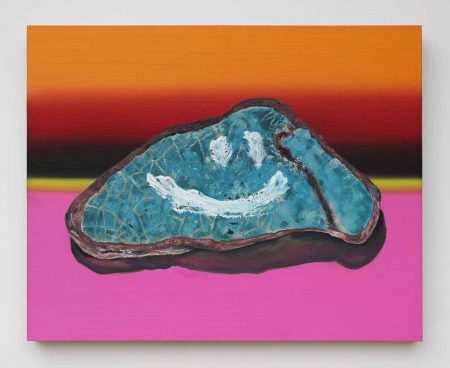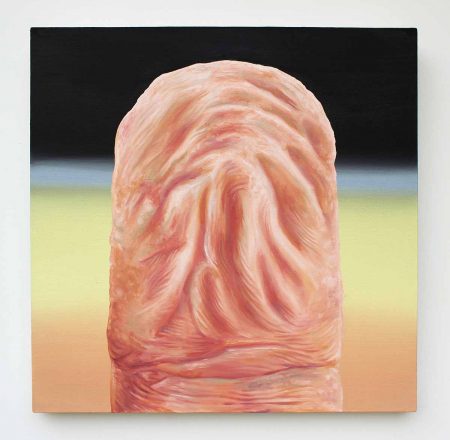Rachel Fischer’s installation at Box 13 Art Space in Houston, in the Front Box, opened on the eighteenth of March and closed on the twenty-second of April. Oddly enough I was headed to Houston on the day of the closing reception and was somewhat dismayed to have missed it by a couple of hours. I have become familiar with Fischer’s work since then through the photographs she has sent me. I also spoke with Fischer on the phone, conducting a nearly two-hour long interview and discussion of many things.
The space, The Front Box, is just one of many within the BOX 13 Art Space which houses six innovative exhibition spaces and affordably priced studio spaces for artists. The front Box is a large window space where the viewer relates to the work proximally, and then the work also relates to the work in a similar manner, especially with Fisher’s mixture of painting and sculpture. Further, Fischer is, with Low Tide, having a multifaceted conversation with herself about painting’s relationship to sculpture, the posture of form all together, the way she’s been marked by her experience with new age religion, and how art exists in relation to infinity and the healthy humor therein. This body of work seems to be a reinvestment in mystery and self-love for Fischer, a fresh re-engagement, and an ah-hah moment in her journey as an artist.
The installation consists of a series of paintings, many of which feature a central, and somewhat mundane totem against a gradient suggestive of horizon.
The installation includes traces of Fischer’s sculptural and painterly tendencies. She related that this is her first return to straightforward, and much less figurative painting, in many years. Most of her more recent work had been sculptural, although very painterly; her working process has seemed much more concerned with material affect, surface, color and protrusion from the wall. Her works featured in this past year’s Issue #126 West of New American Paintings, seemed to bridge a gap between sculpture and painting, occupying a space of pronounced negotiation. Before this exhibition, Fischer had exhibited some of the paintings in Low Tide hung on pieces of ply board leaned against the gallery wall. This gesture was supposed to function in a very literal way as a negotiation between sculptural and painted forms. This body of work is further still a turning point, a reconfiguring, and a tidal shift. Fischer says that her work has always been very personal, and in looking back one can surmise a calculated personal lexicon. She explained that when she talks to people about her work, in the past and now, sexuality and gender have often been buzz words. She said that gender and sexuality do not have much bearing on the work, or not as much as people want to interject. The tendency for people to read social politics into the work comes from the inclusion of her own body.
The inclusion of her own physical self is complicated and seems to be rooted partially in her own artistic roots in realism, but is more concerned with introspection for the purpose of spatial self-orientation. Parts of the artist’s body are parsed from the whole and set against a gradient which suggests infinity, or the extension of time. Their appearance is awkward against such bright expanse. I think Fischer is angling the self in laughable opposition to a performative continuity of humanity that could be misconceived as self-aggrandizing but instead approaches sarcasm. She is positioning herself against the broader idea of “world,” and Fischer is garnering strength from the idea of enlightenment from the inconsequential. The other objects that Fischer has set against horizon include laughable characters such as the pet rock in Monument 6. When she described it over the phone Fischer spoke imaginatively, suggesting the what if all of humanity where to end and all that was left to signify of gesture in the end was a stupid grinning pet rock.
During our conversation Fischer spoke to the subject of Monument 7 (Infinite Loop), which is in fact a Ding Dong, and said that it wasn’t normally something that she would paint. I would have to agree that it is un-alike many of the other images included, in that its pop-cultural matter is very great. Its difference is what lends this painting its illustrative verbosity. I think that much of what Fischer is interpreting is along the lines of the typifying qualities of transcendentalism. Fischer related to me that she was brought up in a climate of New Age religion as became popular in the early nineties, a mixture of eastern religion , homeopathy, astrology, and energy healing, Fischer found these human constructs to be more and more bunk as she grew into her own reality. A perspective of duality looking back on that belief system is now what dictates subject and attitude. While Fischer seemed to express a nostalgia and lingering belief in some of these systems, she also seems to wonder more as to whether or not the divine might already be implicit in the mundane.
The splotchy wooden sculptures that break up the wall in frenzied staccato seem to bring notions of the implicit divine full circle. Their language is impulsive and wrought of alchemy and feeling in the hands. Their prescription of form does not preach and yet their singularity is vocal and sustained.
With Low Tide Fischer is wrestling sculpture and painting into a more blendable arena while also unraveling her own systems of belief in relating to the world.
–Jack Wood







